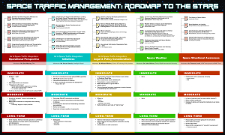Start Date
12-11-2015 1:00 PM
Abstract
Safe Operations Above FL600
Abstract
With the increase in likelihood of near-term development of revenue-generating point-to-point suborbital flights and the increase in high-altitude-long-endurance commercial operations above FL600, the criticality of addressing operations above class A airspace has never been more pressing. While the Federal Aviation Administration describes the National Airspace System, it doesn’t offer a description that includes a top. Technological, physiological, physical and administrative limitations have relegated most air operations to FL600 and below. As that changes, previous work on Space Traffic Management (STM) concepts begin to take on new life and add to sincere considerations for adaptation or changes in existing responsibilities, authorities and capabilities of STM stakeholders. As the FAA transitions to the NextGen architecture, those limitations that prevented humans from routinely operating above FL600 will being to dissolve and new legal and regulatory regimes will need to be developed and their impact on existing international agreements will require global consideration of STM implementation. Without the technical facility-limitations of Very High Frequency Omni-direction Ranges (VORs) as the primary navigation component of the National Airspace System , a satellite-based system opens up the possibility of redefining the top of class A airspace and the top of the U.S. National Airspace System to, potentially, the Kármán line and providing the responsibility, authority, and capability the FAA currently lacks above FL600. This idea would foster routine, revenue-producing, point-to-point suborbital flights and help to sustain a safe, accessible space domain. The U.S. Senate has recently offered legislation to begin addressing the need for a STM concept and recent developments in the Department of Defense suggest a willingness to begin earnest efforts toward sharing the Joint Space Operations Center workload.
Area of Interest
Space Situational Awareness
Included in
Air and Space Law Commons, Aviation Safety and Security Commons, International Law Commons, Law and Politics Commons, Management and Operations Commons, Military, War, and Peace Commons, National Security Law Commons, Tourism and Travel Commons

Safe Operations Above FL600
Safe Operations Above FL600
Abstract
With the increase in likelihood of near-term development of revenue-generating point-to-point suborbital flights and the increase in high-altitude-long-endurance commercial operations above FL600, the criticality of addressing operations above class A airspace has never been more pressing. While the Federal Aviation Administration describes the National Airspace System, it doesn’t offer a description that includes a top. Technological, physiological, physical and administrative limitations have relegated most air operations to FL600 and below. As that changes, previous work on Space Traffic Management (STM) concepts begin to take on new life and add to sincere considerations for adaptation or changes in existing responsibilities, authorities and capabilities of STM stakeholders. As the FAA transitions to the NextGen architecture, those limitations that prevented humans from routinely operating above FL600 will being to dissolve and new legal and regulatory regimes will need to be developed and their impact on existing international agreements will require global consideration of STM implementation. Without the technical facility-limitations of Very High Frequency Omni-direction Ranges (VORs) as the primary navigation component of the National Airspace System , a satellite-based system opens up the possibility of redefining the top of class A airspace and the top of the U.S. National Airspace System to, potentially, the Kármán line and providing the responsibility, authority, and capability the FAA currently lacks above FL600. This idea would foster routine, revenue-producing, point-to-point suborbital flights and help to sustain a safe, accessible space domain. The U.S. Senate has recently offered legislation to begin addressing the need for a STM concept and recent developments in the Department of Defense suggest a willingness to begin earnest efforts toward sharing the Joint Space Operations Center workload.



Comments
Stephen Hunter’s Bio